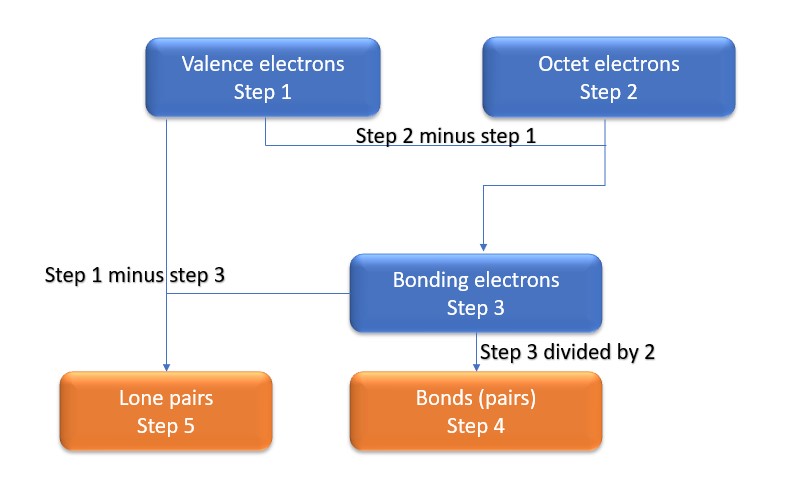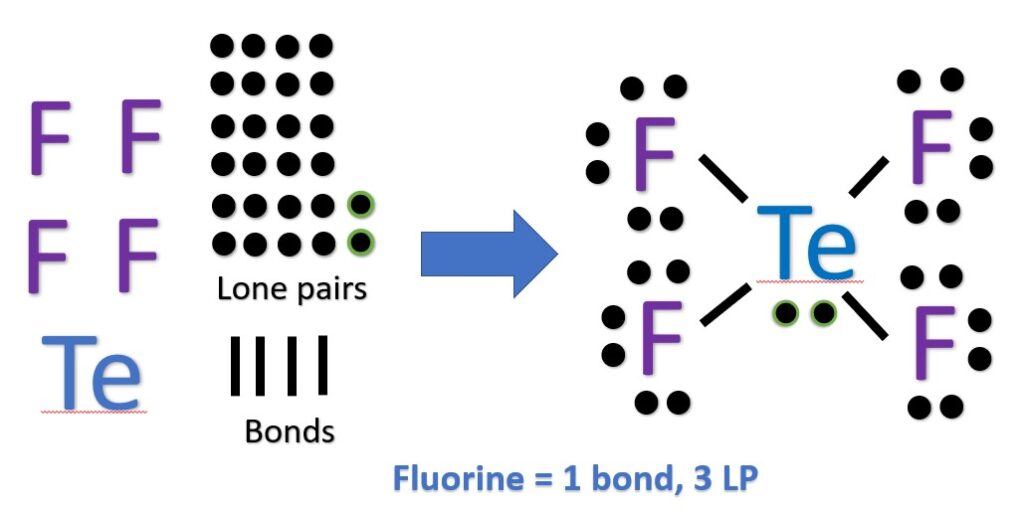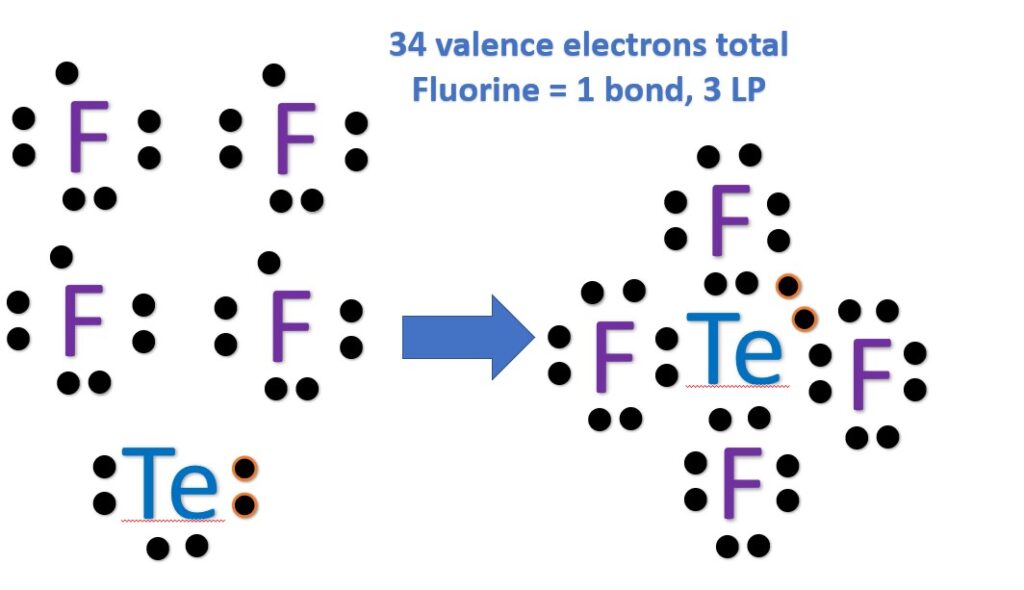What is the Lewis Structure of TeF4?
What is the Lewis Structure of TeF4? The Lewis structure has tellurium as the central atom, with 4 fluorine atoms attached. Each fluorine atom has three lone pairs, while the tellurium atom has one lone pair. This means that Te has an expanded octet of ten, which is possible because .
What is TeF4 and what is it used for?
TeF4, known as tellurium tetrafluoride, is a molecule that you probably will never run into in your labs or in real life. It is a highly reactive and unstable molecule which does not have specific uses in industrial processes. It is mainly used in research settings, and even then, rather sparsely. Tellurium metal is found in the same group as sulfur and oxygen, giving it 6 valence electrons.
Method 1: Step method to draw the Lewis structure of TeF4. [THE HARD WAY]
In this method, we find the bonds and lone pairs for the whole molecule, then plug it in to the atoms that we have to get the answer. Here is a little flow chart of how we are going to do this:

HOWEVER, the case of TeF4, we are going to see that this does not work the first time we try it. That is because Te, IN THIS MOLECULE, has an octet of 10. In can do this because it has a 3d shell which can accommodate an expanded octet, which is necessary for the Te to be able to handle four fluorine atoms.
So…to do this correctly using the math method, we are going to have to fail the first time through. Here we go:
We will go through the steps below to find the Lewis Structure of TeF4, but one thing to note here is that all the valence electrons (step 1) are either lone pairs OR bonding electrons. In other words…. Lone Pairs (Step 5) + Bonding electrons (Step 3) = Valence electrons (Step 1) . Let’s go through this example so we can see this a little more clearly.
Step 1: Find valence electrons for all atoms. This is determined by looking at which column on the periodic table the atom is in, ignoring the transition metals in the middle. Add the valence electrons for each atom together.
Te : 1×6 = 6
4F: 4×7 = 28
Total = 34 valence electrons
Step 2: Find octet electrons for each atom and add them together. Most atoms like 8 electrons to form an octet.
Te: 1×8 = 8**
4F: 4×8 = 32
Total = 40 “octet” electrons
** This is not what it is going to end up being, we are just doing this way to prove a point.
Step 3: Find the number of bonding electrons. Subtract the valence electrons (step 1) from the octet electrons (step 2). This gives the number of bonding electrons.
40-34=6 bonding electrons. [this is not correct]
Step 4: Find number of bonds by diving the number of bonding electrons (step 3) by 2 because each bond is made of 2 e-
6 bonding electrons/2 = 3 bond pairs [also wrong]
We know this answer is not right because there are four F atoms that need to be bonded to Te. This way says there are only three bonds! We need to go back and do it again, this time expanding the Te octet from 8 to 10 to accommodate all four fluorine atoms bonded to Te.
Let’s start over, this time with an octet of 10 for Te:
Step 1: Find valence electrons for all atoms. This is determined by looking at which column on the periodic table the atom is in, ignoring the transition metals in the middle. Add the valence electrons for each atom together.
Te : 1×6 = 6
4F: 4×7 = 28
Total = 34 valence electrons
Step 2: Find octet electrons for each atom and add them together. Most atoms like 8 electrons to form an octet, however Te will be the exception and will have an octet of 10.
Te: 1×8 = 10**
4F: 4×8 = 32
Total = 42 “octet” electrons
** Expanded octet so that all four F atoms can bond.
Step 3: Find the number of bonding electrons. Subtract the valence electrons (step 1) from the octet electrons (step 2). This gives the number of bonding electrons.
42-34=8 bonding electrons.
Step 4: Find number of bonds by diving the number of bonding electrons (step 3) by 2 because each bond is made of 2 e-
6 bonding electrons/2 = 4 bond pairs [now it is right]
Step 5: Find the number of nonbonding (lone pairs) electrons. Subtract bonding electrons (step 3) number from valence electrons (step 1).
34 valence – 8 bonding = 26 electrons = 13 lone pairs
Now, use the information from step 4 and 5 to draw the Lewis structures. Remembering too (this is important):
Fluorine atoms have one bond and three lone pairs
[Note: For more information on the natural state of common atoms, see the linked post here.]
The tellurium atom will be our central atom because it is the most electropositive. We then place the fluorine atoms around it, with each getting one bond and three lone pairs. The remaining lone pair will go on tellurium.

Another (way easier) method to determine the Lewis structure of TeF4:
Alternatively a dot method can be used to draw the Lewis structure.
Calculate the total valence electrons in the molecule.
Te : 1×6 = 6
4F: 4×7 = 28
Total = 34 valence electrons
Now, treat the atoms and electrons like puzzle pieces. Tellurium goes in the middle, with each fluorine connected to it. We know that each fluorine get three lone pairs and one bond. That means that the remaining valence electrons, 1 lone pair to be exact, must go on tellurium.

Frequently asked questions:
Q: So what is the difference between the two methods?
A: In the first method, we are figuring out all of the lone pairs and bonds first, then placing those electrons and bonds on the atoms to form a molecule. In the puzzle method, we already have lone pairs and bonding electrons assigned to each atom, so all we need to do is push puzzle pieces together to get a molecule. In each method, we need to remember the “happy state” of each atom, ei hydrogen likes 1 bond and no lone pairs, uncharged carbon likes four bonds and no lone pairs ect.
Q: Why did we do the Lewis Structure of TeF4 the wrong way the first time for method 1?
A: What we were trying to show is that if you use the math method, you have to make sure your answer is correct with respect to the number of bonds in the Lewis structure you are creating. In this case, the bonds were off b/c we were using 8 as the octet for tellurium instead of 10.
Q: Why does tellurium have an octet of 10?
A: Tellurium is in the same column as oxygen and sulfur, which means it has six valence electrons. However, unlike sulfur and oxygen, tellurium has the 3d shell in its electron configuration, and can tap into that shell to hold electrons and have a higher octet than 8 in order to form certain compounds, like TeF4.
And now some video:
This is a quick video we put together that visually demonstrates the two methods for Lewis structure and Lewis dot problems.
And finally, the Lewis structure study guide:
Here it is, this is our one-page guide to Lewis Dot and Lewis Structures:

